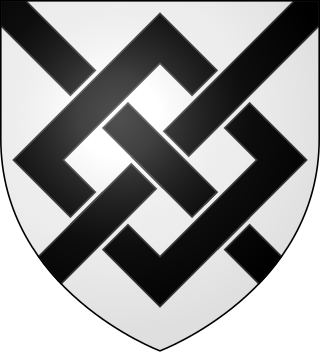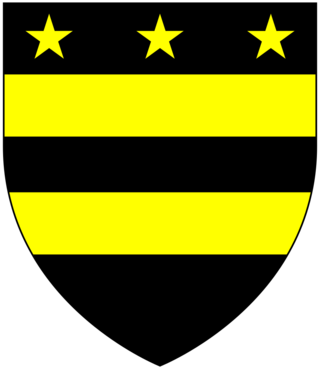Acton baronets, of the City of London (1629)

- Sir William Acton, 1st Baronet (before 1593–1651)
There have been two baronetcies created for persons with the surname Acton, both in the Baronetage of England. One creation is extant. [1]
The Acton Baronetcy, of the City of London, was created in the Baronetage of England on 30 May 1629 for Sir William Acton, a merchant and King Charles I's choice of candidate for the position of Lord Mayor of London in 1640 (he was rejected in the Court of Common Hall election, which was unprecedented). He had no sons and the title became extinct on his death in 1651. His only daughter, Elizabeth, married Sir Thomas Whitmore, 1st Baronet. [2]
The Acton Baronetcy, of Aldenham in the County of Shropshire, was created in the Baronetage of England on 17 January 1644 for Edward Acton, MP for Bridgnorth (first cousin once removed of Sir William Acton). For more information on this creation, see the Baron Acton.


Baron Kilmaine is a title that has been created twice, both times in the Peerage of Ireland. The first creation came in 1722 in favour of the soldier the Hon. James O'Hara. Two years later he succeeded his father as Baron Tyrawley. However, both titles became extinct on the second Baron Tyrawley's death in 1773 without legitimate sons.
There have been ten baronetcies created for persons with the surname Browne, six in the Baronetage of Great Britain, three in the Baronetage of Ireland and one in the Baronetage of Nova Scotia. Only one creation is extant as of 2010. Three of the creations were for members of the Browne family headed by the Viscount Montagu.

There have been six baronetcies created for persons with the surname Smyth, two in the Baronetage of England, one in the Baronetage of Great Britain, one in the Baronetage of Ireland and two in the Baronetage of the United Kingdom. One creation is extant as of 2010.
There have been four baronetcies created for persons with the surname Leslie, one in the Baronetage of Nova Scotia, one in the Baronetage of Ireland, one in the Baronetage of Great Britain and one in the Baronetage of the United Kingdom. Three of the creations are extant as of 2010.

There have been twenty one baronetcies created for persons with the surname Williams, eight in the Baronetage of England, three in the Baronetage of Great Britain and ten in the Baronetage of the United Kingdom. Only six of the creations are extant as of 2017.

There have been three baronetcies created for members of the Vernon family.

There have been four baronetcies created for persons with the surname Hope, three in the Baronetage of Nova Scotia and one in the Baronetage of the United Kingdom. As of 2010 one creation is extant, one dormant and two extinct.

There have been eight baronetcies created for persons with the surname Wilson, one in the Baronetage of Ireland and six in the Baronetage of the United Kingdom.

There have been two baronetcies created for persons with the surname Freke, one in the Baronetage of Great Britain and one in the Baronetage of Ireland.

There have been three baronetcies created for persons with the surname Cooke, two in the Baronetage of England and one in the Baronetage of Ireland. One creation is extant as of 2013.

There have been two baronetcies created for persons with the surname Yelverton, both in the Baronetage of England.
There have been two baronetcies created for people named Cole, one in the Baronetage of England and one in the Baronetage of Ireland.
There have been two baronetcies created in the Baronetage of England for members of the Colepeper family of Kent and Sussex. Both are extinct.

There have been four baronetcies created for persons with the surname Cope.
There have been three baronetcies created for persons with the surname Duncan, one in the Baronetage of Great Britain and two in the Baronetage of the United Kingdom. All three creations are extinct.
Sir William Acton, 1st Baronet was an English merchant and Royalist who was Lord Mayor of London in 1640.
There have been two baronetcies created for persons with the surname Brydges, one in the Baronetage of England and one in the Baronetage of the United Kingdom. Both creations are extinct.
There have been three baronetcies created for persons with the surname Humble, two in the Baronetage of England and one in the Baronetage of the United Kingdom. All are extinct.
The Brabazon Baronetcy, of Newpark in the County of Mayo, was a title in the Baronetage of Ireland. It was created on 16 December 1797 for Anthony Brabazon. He was the eldest son and heir of George Brabazon, of New Park in County Mayo, fourth in descent from Sir Anthony Brabazon of Ballinasloe Castle, younger brother of Edward Brabazon, 1st Baron Ardee, ancestor of the Earls of Meath. His son, the second Baronet, represented County Mayo in Parliament. The title became extinct on his death in 1840. Brabazon Park was eventually inherited by Hugh Brabazon Higgins, only son of Luke Higgins of Castlebar by his second wife Catherine, sister of Sir Anthony Brabazon. He was a Captain in the 15th Hussars, and adopted the surname of Brabazon by royal licence of 15 September 1852. He died in 1864, leaving issue.

Earl of Arran is a title in the Peerage of Ireland. It is not to be confused with the title Earl of Arran in the Peerage of Scotland. The two titles refer to different places: the Aran Islands in Ireland, and the Isle of Arran in Scotland. The Irish earldom is held by the Gore family. The Scottish earldom is a separate title, held as a subsidiary title of the Duke of Hamilton.